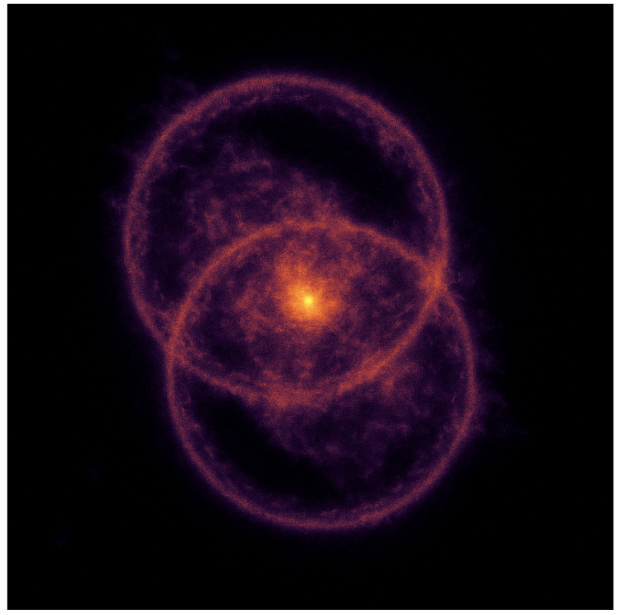
Discovery of the Most Powerful Odd Radio Circle to Date
03-10-2025
Astronomers have discovered the most distant and most powerful “odd radio circle” (ORC) ever observed – with key contributions from a researcher at the Astrophysics division of the National Centre for Nuclear Research (NCBJ).
ORCs are a newly recognised class of cosmic structure, first noticed only six years ago. They are vast, faint, ring-shaped clouds of radio emission made of magnetised plasma, some more than twenty times the size of our Milky Way galaxy. Their origins remain a matter of active research, with theories ranging from the shockwaves of merging black holes to powerful winds blowing from galaxies.
The new object, named RAD J131346.9+500320, lies at a redshift of about 0.94, meaning we see it when the Universe was half its present age. With a diameter of nearly a million light-years, it is the most powerful ORC discovered so far – and only the second ever seen with two intersecting rings.
The discovery was made through the RAD@home Astronomy Collaboratory, a citizen science initiative, using data from the LOFAR radio telescope, a pan-European facility and the world’s most sensitive low-frequency radio observatory.
The 2nd leading author- Dr Pratik Dabhade (NCBJ, Warsaw) explained:
“These results show that ORCs and related radio rings are part of a broader family of exotic plasma structures created by the interplay of black holes, winds, and galaxy environments. The fact that citizen scientists found them reminds us of the continued value of human eyes, even in the age of artificial intelligence.”
Dr Ananda Hota (University of Mumbai), who led the study and is the founder of RAD@home, said: “This work shows how professional astronomers and citizen scientists together can push the boundaries of scientific discovery. ORCs are among the most bizarre and beautiful cosmic structures we've ever seen - and they may hold vital clues about how galaxies and black holes co-evolve, hand-in-hand.”
The research team also reports two other unusual giant radio galaxies. RAD J122622.6+640622, almost three million light-years across, shows one of its jets bending sharply and blowing a ring 100,000 light-years wide. Meanwhile, RAD J142004.0+621715, stretching 1.4 million light-years, displays a similar ring at the end of a narrow jet.
All three objects are found in galaxy clusters weighing about 100 trillion Suns, suggesting that interactions of relativistic magnetised plasma jets with the surrounding hot thermal plasma may help shape these rare rings.
The discovery also comes at a significant time for Polish astronomy. NCBJ is one of eight institutions that have just joined forces to establish the Polish SKA Consortium, preparing the country’s community to take part in the Square Kilometre Array Observatory (SKAO) – the world’s largest radio telescope now under construction. Linking citizen science discoveries with Poland’s growing role in major international projects highlights the expanding impact of Polish research in global astrophysics.
Future facilities such as the SKA, alongside major optical surveys like DESI and LSST, will provide deeper insights into these puzzling structures. For now, the three newly discovered radio rings represent a striking step forward in understanding how galaxies and black holes shape their surroundings.
Research Paper link: https://academic.oup.com/mnras/article-lookup/doi/10.1093/mnras/staf1531
Royal Astronomical Society press release link: https://www.ras.ac.uk/news-and-press/research-highlights/most-powerful-odd-radio-circle-date-discovered
Video animation link: https://youtu.be/OwK2n0aR1pQ
Science contacts:
1) Dr Pratik Dabhade, Astrophysics Division, National Centre for Nuclear Research, Warsaw, Poland
2) Dr Ananda Hota, (UM-DAE CEBS & CETACS, University of Mumbai, India & RAD@home Astronomy Collaboratory)





